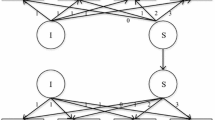Abstract
This study assessed continuity of problematic sexualized behaviors (PSB) over a 1-year period. Ninety-seven 10–12-year-olds in either foster boarding homes or a residential treatment center participated at Time 1. Twelve months later, 78 youth were available for a second data collection assessment. At both data collection phases, researchers interviewed foster parents or primary therapists about the youths' sexual behavior. Findings revealed significant continuity in PSB over time, with children who at Time 1 exhibited PSB significantly more likely to exhibit PSB at Time 2. The reverse was also true in that the absence of PSB at Time 1 was associated with the absence of PSB at Time 2. In addition, a subset of specific PSB behaviors was noted to be most stable, although this varied across the groups. Youth with PSB exhibited several patterns of persistence in specific behaviors over time, including continuity, a mix of continuity and change, and complete discontinuity. The persistence of PSB over time was most true for the children living in a residential treatment center, the more disturbed group studied. We conclude that the persistence of PSB is more likely when the child has other problematic behaviors.
Similar content being viewed by others
References
Achenbach, T. M. (1991). Manual for Child Behavior Checklist/4-18 and 1991 Profile. Burlington, VT: University of Vermont Department of Psychiatry.
Baker, A. J. L., Gries, L., Schneiderman, M., Parker, R., Archer, & Friedrich, W. N. (in press). Children with problematic sexualized behaviors in the child welfare system. Child Welfare.
Baker, A. J. L., Kurland, M., Curtis, P., Papa-Lentini, C., & Alexander, G. (in press). Mental health and behavioral problems of youth in the child welfare system: Residential treatment centers compared to therapeutic foster care in the Odyssey Project population. Child Welfare.
Baker, A. J. L., Schneiderman, M., & Parker, R. (2001). A survey of problematic sexualized behaviors of youth in the New York City child welfare system: Estimates of problem, impact on services, and need for training. Journal of Child Sexual Abuse, 10, 67–80.
Barbaree, H. E., Marshall, W. L., & Hudson, S. M. (1993). The juvenile sex offender. New York: Guilford.
Bonner, B., Walker, C. E., & Berliner, L. (2000). Final report. Children with sexual behavior problems: Assessment and treatment. Grant No. 90-CA-1469. Washington, DC: National Clearinghouse on Child Abuse and Neglect.
Briere, J. (1996). Manual for the Trauma Symptom Checklist Children. Odessa, FL: Psychological Assessment Resources.
Burton, D. L. (2000). Were adolescent sexual offenders children with sexual behavior problems? Sexual Abuse: A Journal of Research and Treatment, 12, 37–48.
Crenshaw, D. A. (1993). Responding to sexual acting-out. In C. E. Schaefer & A. J. Swanson, (Eds.), Children in residential care: Critical issues in treatment (pp. 19–29). Northvale, NJ: Jason Aronson, Inc.
Farmer, E., & Pollock, S. (1998). Sexually abused and abusing children in substitute care. New York, NY: Wiley.
Finkelhor, D., & Berliner, L. (1995). Research on the treatment of sexually abused children: A review and recommendations. Journal of the American Academy of Child and Adolescent Psychiatry, 34, 1408–1423.
Friedrich, W. N. (1997). Manual for the Child Sexual Behavior Inventory. Odessa, FL: Psychological Assessment Resources.
Friedrich, W. N. (2002). Psychological assessment of sexually abused children and their parents. Newbury Park, CA: Sage.
Friedrich, W. N., Davies, W. H., Feher, E., & Wright, J. (2003). Sexual behavior problems in preteens: Developmental, ecological, and behavioral correlates. Annals of the New York Academy of Science, 989, 95–104.
Friedrich, W. N., Fisher, J., Dittner, C., Acton, R., Berliner, L., Butler, J., Damon, L., Davis, W. B., Gray, A., & Wright, J. (2001). Child Sexual Behavior Inventory: Normative, psychiatric, and sexual abuse comparisons. Child Maltreatment, 6, 37–49.
Friedrich, W. N., Grambsch, P., Broughton, D., Kuiper, J., & Beilke, R. L. (1991). Normative sexual behavior in children. Pediatrics, 88, 456–464.
Friedrich, W. M., Grambsch, P., Damon, L., Hewitt, S. K., Koverola, C., Lang, R. A., Wolfe, V., & Broughton, D. (1992). Child Sexual Behavior Inventory: Normative and clinical comparisons. Psychological Assessment, 4, 303–311.
Friedrich, W. N., Jaworski, T., & Berliner, L. (1994). A survey of therapists' attitudes regarding sexual abuse treatment. APSAC Advisor, 7(2), 17–18, 24.
Gil, E. (1993). Age appropriate sex play versus problematic sexual behaviors. In E. Gil & T. C. Johnson (Eds.), Sexualized children: Assessment and treatment of sexualized children and children who molest (pp. 21–40). Rockville, MD: Launch Press.
Hoyle, S. (2000). The sexualized child in foster care. Washington, DC: CWLA Press.
Lerner, R. M., Lerner, J. V., von Eye, A., Ostrom, C. W., Nitz, K., Talwar-Soni, R., & Tubman, J. G. (1996). Continuity and discontinuity across the transition of early adolescence: A developmental contextual perspective. In J. A. Graber, J. Brooks-Gunn, & A. C. Peterson (Eds.), Transitions through adolescence (pp. 3–22). Mahwah, NJ: Lawrence Erlbaum Associates.
Moffitt, T. (1993). Adolescent-limited and life-course-persistent antisocial behavior: A developmental taxonomy. Psychological Review, 100, 674–701.
Rasmussen, L. (1999). Factors related to recidivism among juvenile sexual offenders. Sexual Abuse: A Journal of Research and Treatment, 11, 69–85.
Sroufe, A. L. (1979). The coherence of individual development. American Psychologist, 34, 834–841.
Wieckowski, E., Hartsoe, P., Mayer, A., & Shortz, J. (1998). Deviant sexual behavior in children and young adolescents: Frequency and patterns. Sexual Abuse: A Journal of Research and Treatment, 10, 293–303.
Worling, J. R., & Curwen, T. (2000). Adolescent sex offender recidivism: Success of specialized treatment and implications for risk prediction, Child Abuse and Neglect, 24, 965–982.
Author information
Authors and Affiliations
Corresponding author
Rights and permissions
About this article
Cite this article
Friedrich, W.N., Baker, A.J.L., Parker, R. et al. Youth with Problematic Sexualized Behaviors in the Child Welfare System: A One-Year Longitudinal Study. Sex Abuse 17, 391–406 (2005). https://doi.org/10.1007/s11194-005-8051-7
Issue Date:
DOI: https://doi.org/10.1007/s11194-005-8051-7




